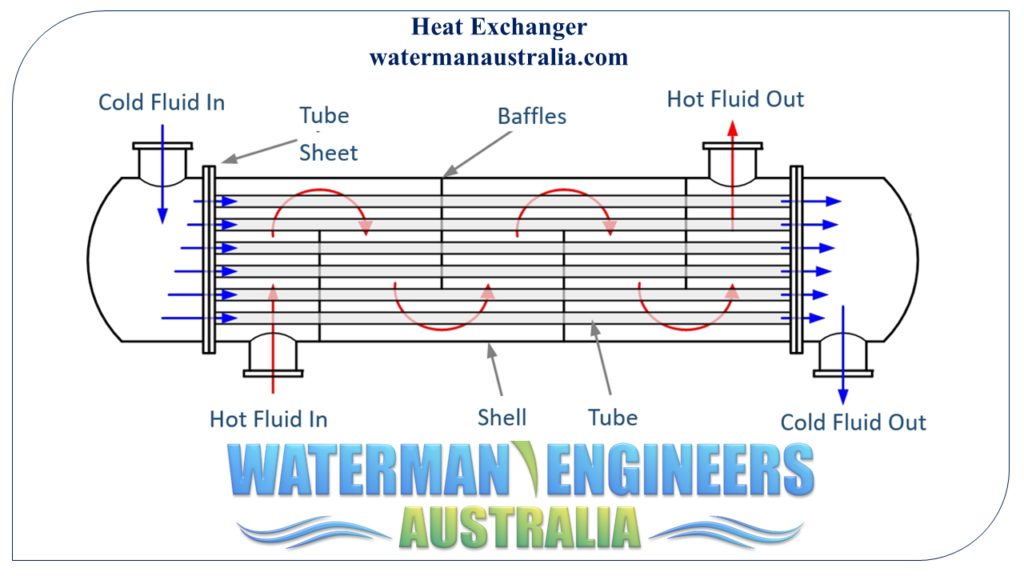
A heat exchanger is a device that allows for the transmission of heat between two different media without any physical contact between them. Heat exchangers work on the idea that thermal energy can be transferred from a hot fluid to a cold fluid. Heat exchangers provide for precise temperature regulation, improving energy efficiency and system functionality by transferring heat between two fluids.
Power plants, chemical plants, HVAC (heating, ventilation, and air conditioning) systems, supermarkets, and many more all employ heat exchangers. They can be found in commonplace home products like air conditioners and water heaters.
In this article, we'll learn about heat exchangers, what they are, how they work, and the different kinds there are. The article also details the common uses and factors to consider when choosing a heat exchanger.
11. Tubesheets. Tubesheets fewer than 100 mm thick are frequently constructed from plate substance. Thicker tubesheets, or for prime integrity service, are constructed from cast discs. Clad plate is commonly employed where by large alloy materials is necessary for system causes. A clad tubesheet includes a carbon or low alloy backing plate of ample thickness to fulfill the tension vessel structure code, that has a layer of the upper alloy product bonded on to it by welding or by explosion cladding. TEMA offers design principles to compute the tubesheet thickness, which give very similar although not equivalent outcomes to the rules in ASME and BS5500. What's more, it specifies tolerances for tube gap diameter, ligament width and for drill drift.
Without a doubt the mechanical layout need to be executed to ascertain the equipment body weight, the situation of supports and that of nozzles, which is determined by the thickness of flanges, positions of welds, and so forth.
Irrespective of whether sq. or rotated sq. pitch need to be made use of relies upon on the diploma of turbulence about the shell side. Where by This is certainly small, as is the situation with viscous liquids, a Designing of heat exchanger manufacturer rotated sq. pitch yields a A lot higher heat transfer coefficient for the same pressure drop. The type of cleaning process (chemical/mechanical) adopted from the client also drives the pitch selection.
“There are hardly any resources and also much less fabrication approaches that may tackle All those pressures and temperatures,” Narayanan mentioned.
Sketch of outside air (getting into the EAHX) and EAHX exit air temperatures for a typical summer months working day. Space higher and decrease setpoint temperatures delimiting Place of work room thermal comfort also represented. Figure four.
The U-benefit or Over-all heat transfer coefficient in an air-cooled heat exchanger is calculated by taking into consideration the heat transfer abilities of the two the air as well as the fluid inside the tubes. It brings together the heat transfer coefficients with the air side, tube facet, along with the tube materials alone.
Addition of the pressure relief machine on the shell facet, ordinarily a rupture disk to be a force protection valve is not fast sufficient
The workforce is establishing large-temperature heat exchangers that must move strength necessities although functioning at 850 °C. The exchangers need to operate at these substantial temperatures and pressures simply because they’re utilizing supercritical carbon dioxide to be a fluid, Rollett mentioned.
Evaporative condensers use a mix of water and air to chill the refrigerant and release heat. They’re extremely efficient, specifically in very hot and dry climates, but demand much more routine maintenance and might consume a significant degree of water.
Solar water heating systems use heat exchanger engineering to transfer the heat through the sun into the circulating h2o with many oblique techniques employing a heat exchanger that is certainly separate within the photo voltaic collectors.
Sketches on the air ingestion specialized House developed higher than ground and with the airflow pathway within the pipes ended up superimposed onto the photograph.
ten. Flanges. A few kinds of flanges are found in shell and tube exchangers, specifically, Girth flanges with the shell and channel barrels; interior flanges within the floating head exchanger to allow disassembly of your internals and elimination with the tube bundle; and nozzle flanges where by the flange and gasket specifications, the dimensions and force ranking is going to be set by the line specification. Determine 5 shows 3 sorts of flanges.
Once the effects element exceeds the TEMA boundaries, impingement security is required. The TEMA expectations specify distinctive rho-v-2 limitations for erosive fluids and nonerosive fluids.
The usage of the method is Evidently facilitated by familiarity with the hot and cold fluid inlet and outlet temperatures.